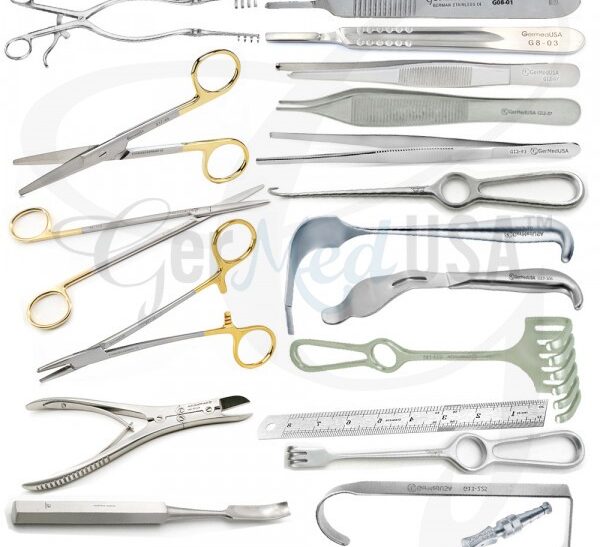In the realm of cardiovascular surgery, precision and efficacy are paramount. The tools used by surgeons must not only be of the highest quality but also versatile and reliable, ensuring that every procedure is performed with the utmost care and accuracy. The intricate nature of cardiovascular surgery demands a profound understanding of the instruments involved, from their design and function to their proper usage and maintenance. Below, we delve into the critical cardiovascular instruments that every surgeon should be intimately familiar with, providing an exhaustive guide that underscores their importance in successful surgical outcomes.
1. Scalpels: The Cornerstone of Surgical Precision
The scalpel is a fundamental instrument in any surgical procedure, and cardiovascular surgery is no exception. These precision instruments are designed to create clean, controlled incisions with minimal trauma to surrounding tissues. In cardiovascular surgery, where access to delicate structures like arteries and veins is necessary, the choice of scalpel is crucial.
Types of Scalpels
- Traditional Scalpels: These are the most commonly used scalpels, featuring a sharp, replaceable blade attached to a reusable handle. The blade sizes vary depending on the procedure, with smaller blades used for more delicate work.
- Laser Scalpels: These advanced tools use a focused laser beam to make incisions, offering the benefit of reduced bleeding and enhanced precision. Laser scalpels are particularly useful in minimally invasive cardiovascular surgeries.
- Electrocautery Devices: While not traditional scalpels, these instruments use electrical currents to cut tissue and simultaneously cauterize the incision site, reducing bleeding and improving visibility during surgery.
2. Forceps: Ensuring a Steady Grip
Forceps are another essential tool in cardiovascular surgery, providing surgeons with the ability to hold, manipulate, and grasp tissues, sutures, and other surgical instruments. The importance of forceps cannot be overstated, as they allow for the delicate handling required in cardiovascular procedures.
Types of Forceps
- Thumb Forceps: Also known as dissecting forceps, these are non-locking forceps that rely on the user’s thumb and fingers to apply pressure. They are used for grasping and holding tissue, often during suturing.
- Hemostatic Forceps: These forceps, such as Mosquito and Kelly forceps, are designed to control bleeding by clamping blood vessels. They are equipped with a locking mechanism to maintain pressure on the vessel until ligation or cauterization is performed.
- Needle Holders: A specialized type of forceps, needle holders are used to grasp and manipulate needles during suturing. They feature a locking mechanism that ensures a firm grip on the needle, allowing for precise stitching.
3. Retractors: Providing Clear Access to Surgical Sites
Retractors are indispensable in cardiovascular surgery, as they are used to hold back tissues and organs to provide surgeons with a clear view and access to the surgical site. The selection of the appropriate retractor is critical, as it must offer sufficient exposure while minimizing trauma to the surrounding tissues.
Types of Retractors
- Self-Retaining Retractors: These retractors have a locking mechanism that holds the tissue in place, freeing the surgeon’s hands. Rib spreaders, for example, are used to hold open the chest cavity during open-heart surgery.
- Handheld Retractors: These require an assistant to hold them in place. They are often used in smaller or more superficial incisions where a self-retaining retractor might be too cumbersome.
- Specialized Retractors: Instruments like sternal retractors are specifically designed for cardiovascular procedures, providing optimal exposure while reducing the risk of injury to the heart and surrounding structures.
4. Cardiovascular Scissors: Precision Cutting
Scissors are crucial for cutting sutures, tissues, and other materials during surgery. In cardiovascular procedures, where precision is essential, the choice of scissors can significantly impact the outcome of the surgery.
Types of Cardiovascular Scissors
- Metzenbaum Scissors: These are the most commonly used scissors in cardiovascular surgery. They are designed for cutting delicate tissues and are available in both straight and curved versions.
- Potts Scissors: Specifically designed for vascular surgery, Potts scissors have a unique angled blade that facilitates the cutting of blood vessels and other tubular structures.
- Tenotomy Scissors: These fine-tipped scissors are used for detailed dissection, particularly in small, delicate areas where precision is key.
5. Sutures and Needles: The Art of Surgical Closure
The choice of sutures and needles is critical in cardiovascular surgery, where the integrity of the closure can determine the success of the procedure. Sutures must be strong enough to withstand the pressures of the cardiovascular system while minimizing the risk of infection or tissue reaction.
Types of Sutures
- Monofilament Sutures: These are made from a single strand of material, offering a smooth surface that reduces tissue drag and minimizes infection risk. They are commonly used for vascular anastomoses and other delicate procedures.
- Braided Sutures: These sutures are made from multiple fibers woven together, providing excellent knot security. However, they have a higher risk of harboring bacteria and causing tissue reaction, making them less suitable for certain cardiovascular procedures.
Types of Needles
- Tapered Needles: These needles have a round body and a pointed tip, allowing them to penetrate tissue without cutting. They are ideal for vascular suturing where minimizing trauma to the vessel wall is important.
- Cutting Needles: These needles have a triangular cross-section, with a sharp cutting edge that allows them to penetrate tough tissues. They are used in situations where a stronger needle is required, such as in the closure of the sternum.
6. Clamps: Controlling the Flow
Clamps are vital in cardiovascular surgery, where they are used to control the flow of blood through vessels and to occlude vessels during procedures. The selection of the appropriate clamp can be the difference between a successful surgery and a life-threatening complication.
Types of Clamps
- Vascular Clamps: These clamps, such as Bulldog clamps, are used to temporarily occlude blood vessels during surgery. They must provide a secure hold without causing damage to the vessel.
- Aortic Cross-Clamps: These are large clamps used to occlude the aorta during procedures such as aortic valve replacement. They must be applied carefully to avoid damaging the vessel wall.
- Hemostatic Clamps: These clamps are used to control bleeding by compressing blood vessels. They are often used in conjunction with sutures or electrocautery to achieve hemostasis.
7. Cardiopulmonary Bypass Equipment: The Heart-Lung Machine
In many cardiovascular surgeries, particularly open-heart procedures, the cardiopulmonary bypass machine (CPB) is an essential component. This equipment takes over the function of the heart and lungs during surgery, allowing the surgeon to operate on a bloodless and motionless heart.
Components of the CPB Machine
- Oxygenator: This component oxygenates the blood, replacing the function of the lungs during surgery.
- Pump: The pump circulates the blood throughout the body, replacing the function of the heart.
- Cannulas: These tubes are inserted into the blood vessels to divert blood to and from the CPB machine.
Understanding how to properly set up, manage, and monitor the CPB machine is critical for the success of many cardiovascular surgeries.
Conclusion
The instruments used in cardiovascular surgery are not merely tools but extensions of the surgeon’s skill and precision. Mastery of these instruments is essential for ensuring successful outcomes in complex cardiovascular procedures. From scalpels to clamps, each instrument plays a critical role in the delicate balance of surgery, where precision and control are paramount.
Feel free to submit more guest posts through Links Building Servcies - Best Prices. Buy Author Account / 1$ Guest Post Here























